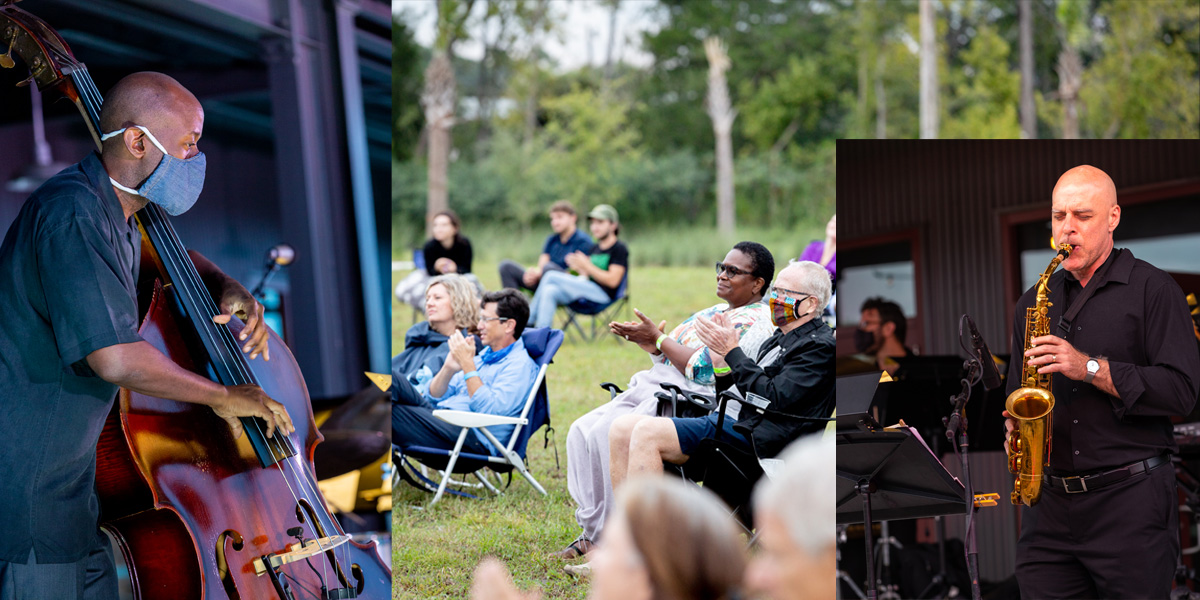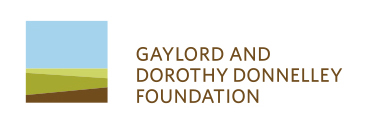
COVID-19’s Impact on the Arts in the Lowcountry
The Arts Response to COVID-19 – Report on group conversations with Lowcountry arts organizations and the Gaylord and Dorothy Donnelley Foundation
By: Kerri Forrest and Ame Holcombe
Header images provided by Charleston Jazz of a late September 2020 performance, their first live since COVID began.
Living in the South Carolina Lowcountry has taught us preparation and resilience – to hurricanes, rising sea levels, and in 2020, a pandemic. The COVID-19 pandemic hit swift and hard in mid-March and, by the end of the month, forced all non-essential businesses to close in South Carolina. Lowcountry arts organizations, which bring in more than $250 million [1] in annual revenue, are now in the midst of a public health crisis that brings historic economic consequences. With many unknown challenges ahead, the Gaylord and Dorothy Donnelley Foundation (GDDF) staff is sharing the Lowcountry arts' collective response to the pandemic, gathered over several conversations, to highlight challenges in the sector and to encourage further preparation for the future.
Introduction
In early March, the Lowcountry was buzzing with arts events – performances, exhibitions, fundraisers, workshops, and classes. Local and international arts festivals were about to begin. As more and more cases of COVID-19 were reported across the state, Governor Henry McMaster mandated closures to keep people 'socially distant' and safe and everything came to a halt. Lowcountry arts groups began processing how best to respond. With a field so dependent on in-person interaction, how would artists and patrons stay connected? With earned revenue at a standstill, how would they survive?
'Artists are second responders. They respond to emotional and mental health needs and can help in coming out of this crisis.' – GDDF Arts Grantee
Concerned about the field's overall well-being, GDDF staff arranged seven small-group Zoom conversations, beginning in April through June, with thirty-eight grantee arts organizations located up and down the South Carolina coast. These conversations gave organizations a space to share as a community the most significant challenges, the uncertainty of the future, and some innovations in times of crisis.
Managing Finances
Across the country, business and nonprofit closures resulted in millions of dollars in lost revenue and jobs. Lowcountry arts organizations were no exception. In the early days of the pandemic, the Federal government passed The Coronavirus Aid, Relief and Economic Security Act [2], which offered several assistance programs, including the Paycheck Protection Program (PPP). The quickly developed program created a range of frustrations for organizations having to navigate the system in a relatively short period. Many organizations noted that the PPP application process was complicated, and leadership teams had to wrap their heads around the process quickly to apply.
For the Latinx community, one organization reported, access was even more complex. The organization, which supports Latinx artists across the state, scrambled to translate the bailout package into Spanish; unfortunately, by the time this was done, the first round of funding had run out.
Finding a lender was challenging for many small arts organizations. Those who received PPP funds early on had more success going through local lenders rather than through larger, national banks. They also shared similar organizational processes – a loan policy in place with their board, good board communication, and well-organized, accessible financials. For Lowcountry arts grantees, approximately 30% received PPP funds. Now that PPP funds have run out for those who took the first round, organizations are having to balance how much debt they are willing to take on with the long-term uncertainty of the virus.
'My biggest concern is getting sponsors for next year. We did ask one to renew and they said no because they don't know what their future is going to be. So we learned to hold off until this all gets resolved.' – GDDF Arts Grantee
In addition to taking on unplanned debt, the pandemic forced arts directors and boards to quickly re-forecast budgets and furlough staff, cut expenses, and adjust fundraising. Less than 1/3 of arts organizations in the portfolio had six months of cash reserves when the pandemic halted the economy. With no indication of when live performances might resume, contributed income was of great concern. Some organizations reported receiving individual donor contributions but were uncertain how long that would continue. According to the organizations, grant funding from GDDF and the South Carolina Arts Commission was the only immediate philanthropic support, with a few organizations also receiving awards from the National Endowment for the Arts and the National Endowment for the Humanities.[3]
Planning
Planning for performances and in person activities continued to be a moving target with infection rates skyrocketing in June, a looming threat of a COVID-19 second wave in the fall, and a potentially active hurricane season. Few organizations had short-term plans for hurricane interruptions, and the long-term implications of the pandemic brought emergency planning to a whole new level.
Soon after the economy shut down in late March, many organizations began developing 3-12 month plans, but a few still struggled with how to move forward. Arts leaders considered both the short-term impacts of the quarantine, including staffing and fundraising plus future issues such as reopening venues to limited audiences with safety concerns and liability implications.
Programming
Many organization leaders realized early on that to maintain engagement, they would need to provide online programming. Several arts organizations quickly began producing online content – including performances, classes, and workshops- and although not yet monetized, the offerings have brought new audiences and supporters. Music and visual arts organizations were less hesitant to share their work online. Many theatre and dance groups found it difficult to produce work via Zoom without diminishing artistic merit, although some have since ventured into the space.
'We all know in the arts that very little of what we do comes easily. Figuring out the technology -imagine having to run lights if you haven't run lights before. So trying to run a zoom meeting – its brand new, why would you know how to do it? We need to give ourselves a little bit of leeway. ' – GDDF Arts grantee
All groups noted copyright challenges with sharing work online. A few organizations discussed possible collaborations and outdoor performances once pandemic restrictions ease; others planned to delay the start of the upcoming season for 3- 6 months. Hybrid seasons were also being considered, with online and in-person attendance options. Surveys to patrons and supporters were also used by some groups to help guide their scenario planning.
Social Justice and the Arts
The deaths of George Floyd, Breonna Taylor, and Ahmad Arbery, and the national uprising that followed, occurred just as conversations with the arts organizations were nearing conclusion. Unfortunately, due to the timing of the calls, the GDDF staff was unable to spend time discussing racial and social injustice with all of the groups. However, these are issues that we will continue to explore with grantees as they consider their own responses and the responsibility of the arts field to engage in social justice issues.
Conclusion
Being the first to close and the last to open, the pandemic has hit the arts exceptionally hard. Arts organizations have faced challenges during the COVID-19 pandemic that not everyone understands – except other arts organizations. Holding group conversations was a reminder that there is value in sharing experiences as an arts community. It builds resilience across the sector. These are unprecedented times that require unprecedented efforts. The next 6-12 months will be very challenging, but communicating, planning, collaborating, coordinating work, sharing ideas, and promoting public understanding and support can all help the arts come out of this crisis better prepared and a stronger, more resilient arts community in the future.
To download and read the full report, please complete and submit the form below:
[1] Arts &Economic Prosperity 5: The Economic Impact of Nonprofit Arts and Cultural Organizations and Their Audiences report. Americans for the Arts. 2017.
[2] https://home.treasury.gov/policy-issues/cares
[3] Kite Foundation provided capacity building support to several organizations.


Sorry, the comment form is closed at this time.